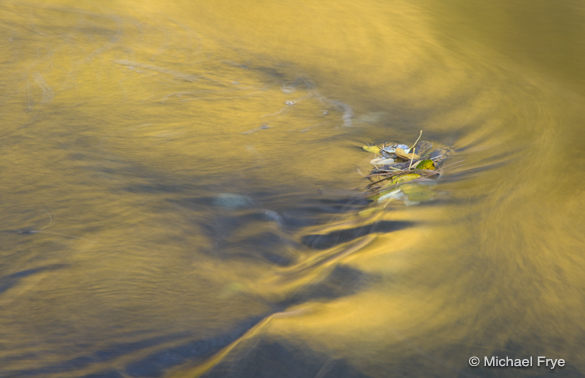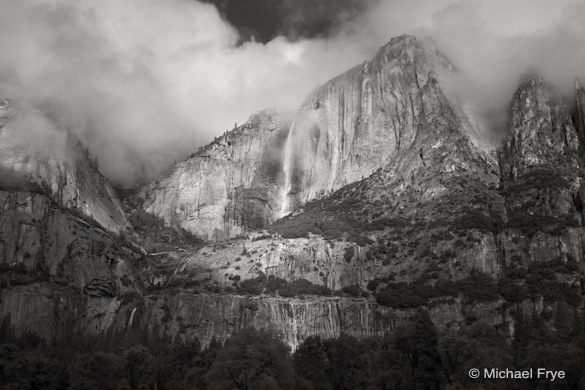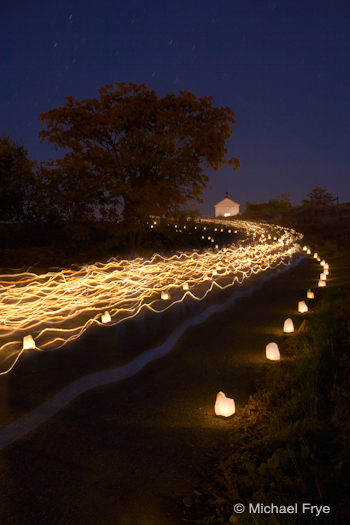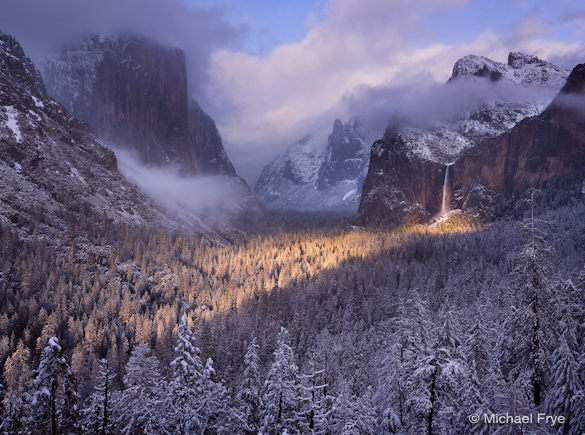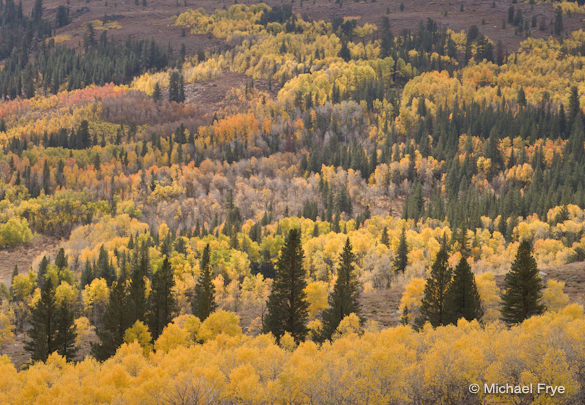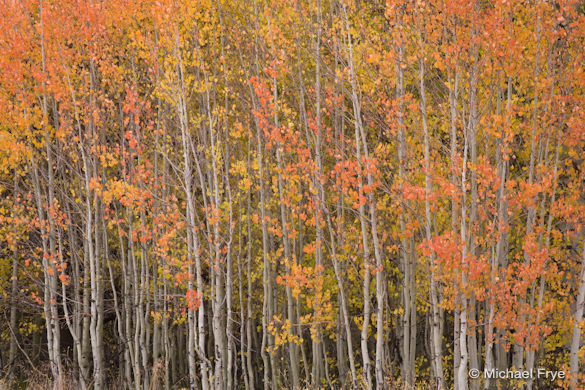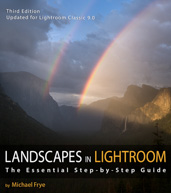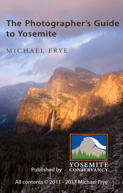In the Moment:
Michael Frye's Landscape Photography Blog
by Michael Frye | Nov 8, 2010 | Yosemite Photo Conditions
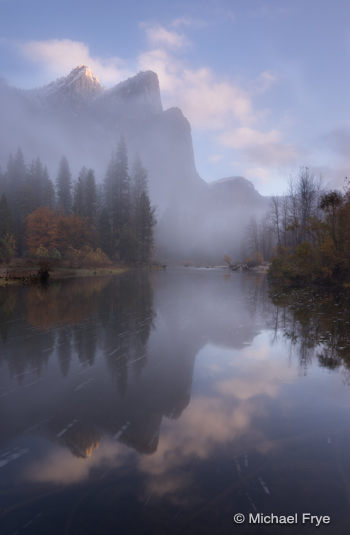
What a magical day it was in Yosemite Valley. The storm cleared overnight, and Claudia and I rose early to make the drive to the park. We saw a misty sunrise, a dramatic sunset, and beautiful fall color. Everywhere I looked there was another photograph, and another, and another—all demanding to be captured. I did my best to oblige. Here’s a morning view of Three Brothers in the mist; I’ll post more images soon.
Although some leaves were knocked down by the storm, most survived, and it looks like we’ll still have plenty of autumn color through this weekend.
First light on Three Brothers, around 7:00 a.m. this morning
by Michael Frye | Nov 7, 2010 | Yosemite Photo Conditions
Cottonwood leaves and reflections in the Merced River, Yosemite
What a difference a week makes. Last Sunday, October 31st, the color in Yosemite Valley was progressing, but still not there yet. Yesterday I returned to the valley for a private workshop and found colorful leaves everywhere. All the deciduous trees—maples, dogwoods, cottonwoods, and oaks—are turning. Green leaves, abundant a week ago, are now in a small minority. All four species of deciduous trees are close to, or at, their peak autumn color.
Most years the maples and dogwoods turn before the oaks and cottonwoods, so the color is spread out over several weeks. It’s unusual for all these trees to be near peak at the same time, and I’ve seldom seen the valley look more beautiful than it did yesterday. I don’t know how long this will last. A significant storm arrived today, and forecasters are predicting one to two feet of snow above 6000 feet. While it probably won’t snow in Yosemite Valley, at 4000 feet, the rain will knock down some leaves—although surely not all of them. I’m planning to go up to the valley again tomorrow when the storm clears, so I’ll let you know what I find.
This storm has closed Tioga Pass. The pass closes for the winter after the first significant snowfall in November, so it will probably remain closed until spring. My favorite eastern Sierra locations, only a few hours away during the last five months, now require seven hours of driving to reach! I’ve always wanted to visit Mono Lake in winter, so maybe this will be the year, but if not then I’ll return when the pass reopens in May or June.
My five-day workshop, The Digital Landscape: Autumn in Yosemite, finished last week. While the autumn color had not yet reached its peak, we still found many colorful leaves to photograph, and saw some fantastic light and weather, as you can see from this view of Yosemite Falls as a storm was clearing. The group was diverse and interesting, with participants from Sweden, Belgium, New York, Texas, and Minnesota. I think this is the first time I’ve ever taught a Yosemite workshop with no California students! Anyway, thanks to everyone in the group for making this a fun class.
Clearing Storm Over Yosemite Falls
by Michael Frye | Nov 4, 2010 | Night Photography
Day of the Dead procession, Hornitos, California
Last year Claudia and I attended theDay of the Dead (All Soul’s Day) celebration in Hornitos for the first time. Hornitos is a tiny town in the Sierra foothills near my home in Mariposa. During the 1850s over 15,000 people lived there; now the residents number less than a hundred. But every November 2nd the town’s population swells, and several hundred people form a silent, candlelit procession from the town up a hill to the old church and graveyard, where they participate in a ceremony honoring the departed.
As I wrote last year, Claudia and I both found the ceremony moving and inspiring, and knew we had to return. Tuesday night we attended the event for the second time. We loved it, again; in our noisy world it’s wonderful to see hundreds of people holding candles and walking silently, solemnly through the night to an old graveyard. Although neither of us are practicing Catholics, we can appreciate rituals that help connect us with some of the more essential and elemental aspects of life and death.
About the Photograph
Last year I made some good images, but it’s difficult to photograph something like this when you’ve never seen it before, don’t know what to expect, and only have one chance at it. This time I had a plan. I positioned myself where I could see the curving line of the procession walking up the hill toward the church. With the camera locked on a tripod I made an exposure at dusk to capture some of the ambient light, then made a further series of long exposures as the procession passed by. The pieces were assembled in Photoshop. The squiggly lines were made by candles that people held as they walked up the hill. The blue streak is actually the viewing screen of a video camera dangling from a man’s shoulder as he walked up the hill—a nice touch of color, and the line helps fill in an otherwise empty space in the composition.
Some photographs are created spontaneously; others require planning. This is obviously an example of planning, as is my photograph of Horsetail Fall by moonlight. But most of my best images were made by simply reacting to what I saw around me—fleeting light or weather, or maybe just aninteresting arrangement of elements that could make a compelling composition. Planning and flexibility are both essential tools in a photographer’s kit.
Next November 2nd I may leave the camera at home and actually join the procession. Then again, I might not be able to resist trying to capture an event with such rich photographic potential. Either way, I’ll be there.
by Michael Frye | Oct 27, 2010 | Yosemite Photo Conditions
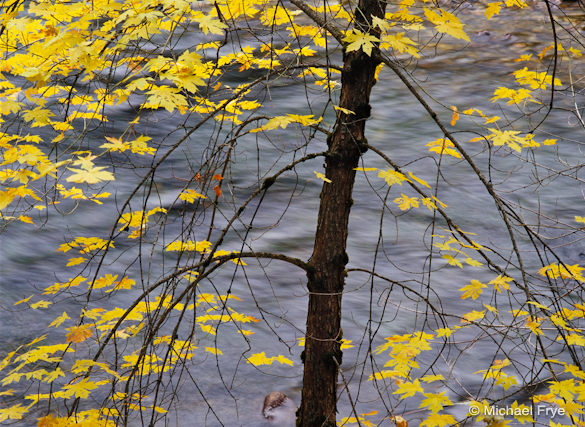
Big-leaf maple… from a few years ago
Fall Color in Yosemite Valley is late—really late. I reported last week that about 50 percent of the maple leaves had turned, 20 percent of the cottonwoods, 20 percent of the dogwoods, and 5 percent of the oaks. Well it’s nearly a week later and I’d say the percentages are the same! Hardly anything has changed. There is some good color in spots: as before, the best places are around Pohono Bridge and underneath Cathedral Rocks along Southside Drive. I heard a reliable report that the dogwoods along Highway 120 are about half turned.
At this point don’t want to even try to predict when the color will peak, or what kind of autumn it might be, as this season is progressing more slowly than any fall I can remember. I’ll let you know if things suddenly start to turn.
by Michael Frye | Oct 26, 2010 | Critiques
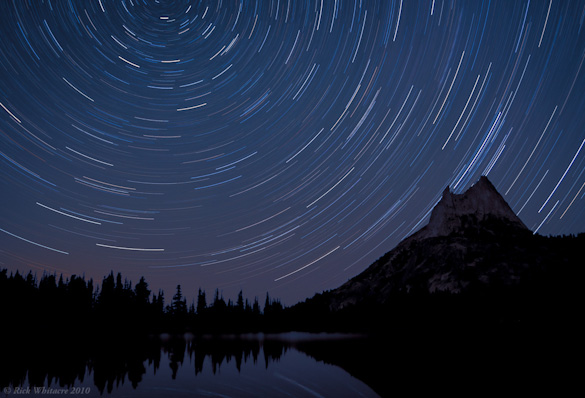
Star Trails and Cathedral Peak by Rick Whitacre
This week’s photograph was made by Rick Whitacre at Upper Cathedral Lake in Yosemite. By having his image chosen for this critique Rick will receive a free 16×20 matted print from Aspen Creek Photo. If you’d like your images considered for future critiques you can upload them to the Flickr group I created for this purpose.
When I saw this image among the submissions for this series, it occurred to me that I hadn’t critiqued a nighttime photograph before, and that doing so might help provide some lessons and insights into night photography.
(more…)
by Michael Frye | Oct 25, 2010 | Vision and Creativity
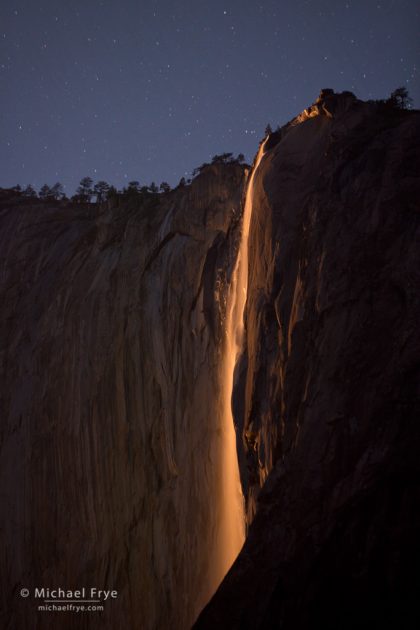
Horsetail Fall by moonlight, Yosemite NP, CA, USA
Horsetail Fall has become a celebrity, attracting more lenses than Brangelina. In February hundreds of photographers try to catch the fleeting sunset light on this little waterfall. Suitable vantage points are limited, so it’s hard to find new and different ways to portray this iconic subject. But it occurred to me that if I could catch the moon setting at just the right angle I might be able to photograph it at night.
It turns out that the right conditions for moonset light on Horsetail Fall are quite rare. The moon’s path varies greatly as it waxes and wanes. It has to set at the right angle while close to full (to provide enough light), before sunrise (so the dawn light doesn’t wash out sky), and there has to be water in the fall. Such conditions may occur only once every other year, at most.
Fortunately I found perfect conditions last spring. As I walked up to one of my favorite Horsetail Fall viewing locations at about 4 a.m., I saw an amazing sight: that beautiful, low-angle backlight on the waterfall, with the cliff behind it in the shade. It looked exactly like it does at sunset in February, only with stars in the sky above it.
Our eyes can’t see color in the dark, but cameras can, so as soon as I made my first test exposure I could see that now-classic orange glow on my LCD screen. I used both short and long shutter speeds, but ended up liking the short ones, with pinpoint stars, best.
This photograph was selected to be part of the Best of Nature show at the Ordover Gallery in the San Diego Natural History Museum. Two more of my images, Winter Sunrise From Tunnel View, and Winter Morning Along the Merced River, were also chosen. The opening reception is November 13th, 11 a.m. to 1 p.m., and will be on view until January 30, 2011. Hope to see some of you at the reception!
Speaking of Horsetail Fall, right now is it’s mirror season. The light is identical to February, and the only reason hundreds of photographers don’t try to photograph it in October is because there’s usually no water in the fall. But Yosemite Valley received almost four inches of rain in the last 48 hours, so there should be plenty of water in Horsetail Fall for the next day or two.
by Michael Frye | Oct 22, 2010 | Announcements, Workshops
Spotlight on Bridalveil Fall, Yosemite National Park
The Ansel Adams Gallery posted their 2011 workshops on their web site today, and they’re open for registration. I’m very happy to announce that I’ll be teaching five classes with the Gallery next year, including a Photoshop and Digital Printing Workshop in January, the Spring Yosemite Digital Camera Workshop in April, and my Hidden Yosemite workshop in July. You can see the complete list on myworkshop page.
There are a few errors on the Gallery’s site, which we’re working to fix. The descriptions on my site are correct, so please refer to these for now, and email me if you have any questions. But I wanted to let you all know that the registration is open, since these classes often fill up quickly.
As you probably know from reading this blog, I love teaching. It’s immensely satisfying to help people find their photographic vision and master the craft of photography. So I’m really looking forward to these workshops next year! Hope to see you in one of them.
by Michael Frye | Oct 21, 2010 | Yosemite Photo Conditions
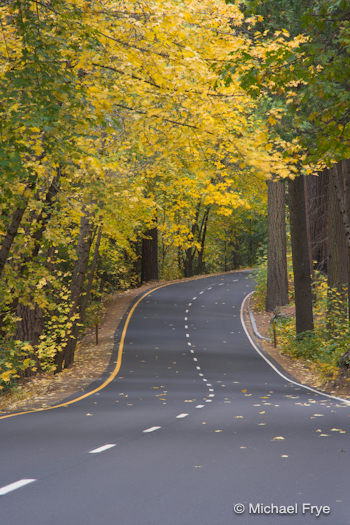
I spent the last two days in Yosemite Valley doing a private workshop. The weather was fantastic—we got to photograph lots of interesting clouds and chiaroscuro light patterns. More potentially photogenic stormy conditions are predicted through the weekend.
The autumn color in the valley is improving every day, but it’s still not quite there yet. There are four main types of deciduous trees in the valley: big-leaf maples, dogwoods, cottonwoods, and black oaks. The maples usually change color first, and this year is no exception. You can find nice displays already near Pohono Bridge and along Southside Drive underneath Cathedral Rocks. I’d say about 50 percent of the maple leaves in the valley have turned as of today.
The other trees are a bit further behind. Perhaps 20 percent of the dogwood and cottonwood leaves have changed so far, and perhaps only 5 percent of the oak leaves. The dogwoods and cottonwoods need at least another week, and the oaks maybe two weeks.
But while the show consists mostly of maples so far, these trees produce the most consistently vibrant and beautiful color in the valley, and they are changing rapidly. I saw a noticeable increase in yellow leaves in just the last 36 hours. So they may peak soon—maybe even this weekend.
by Michael Frye | Oct 19, 2010 | Yosemite Photo Conditions
Claudia and I made it over Tioga Pass on Sunday, and spent the last two days around Lee Vining photographing aspens. It rained off and on, so we had to wait out a few showers, but the moisture intensified the colors, and gave us some interesting clouds and weather to photograph. I made hundreds of exposures, drained two robust batteries in one day, and got thoroughly soaked, but we had a great time—it was just beautiful. I have a lot of images to process, but here are a couple of early favorites.
A lot has changed in the last week, and autumn has finally bloomed in the eastside canyons. Some of the middle and upper elevation areas are at peak, and the lower groves around June Lake and Lee Vining Canyon are getting there. We found some beautiful orange aspens along the Virginia Lakes Road, just above Conway Summit. The Dunderberg Meadow area was gorgeous. Of course the spots that are good now will probably be past peak soon, but I expect June Lake, Lee Vining Canyon, and Lundy Canyon will all be beautiful this weekend.
As for Yosemite Valley, I’ve heard that the color has really started to come out recently, and I’ll be up there the next two days to check first hand.
I have a busy workshop upcoming workshop schedule, and of course I have to get out and photograph the fall color! So I won’t be doing a critique this week, but will post one early next week. Stay tuned—and let us know about autumn color that you find.
Multi-colored aspen leaves
by Michael Frye | Oct 15, 2010 | Yosemite Photo Conditions
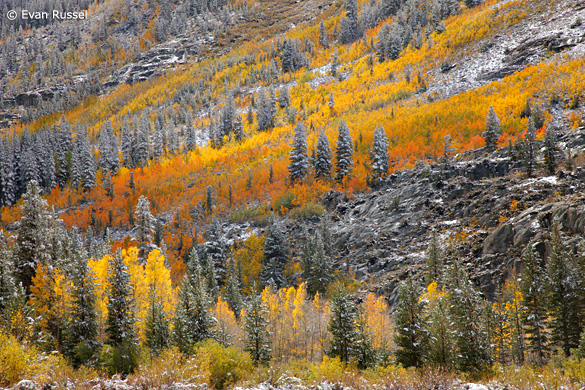
Aspens and snow in the Bishop Creek area, October 5th—Photograph by Evan Russel
After Tioga Pass closed last week I was stuck on the west side of the Sierra, but my friend Evan Russel, Ansel Adams Gallery staff photographer and one of my workshop assistants, made it over there a day earlier, and captured some some great images of snowy aspens after the storm on October 3rd and 4th. Here are a couple of examples. You can see more of Evan’s work on the Gallery’s Facebook page.
Meanwhile in Yosemite Valley autumn is progressing slowly. After some color suddenly appeared last week I thought that the leaves might turn quickly, but apparently the warm weather has slowed things down. I spent the last two days in the valley, and saw some trees that have partially changed, but none fully clothed in their fall colors. Claudia checked out the dogwoods along Highway 120 between the entrance station and Crane Flat and saw mostly green leaves, so it seems that even the higher-elevation trees haven’t changed yet.
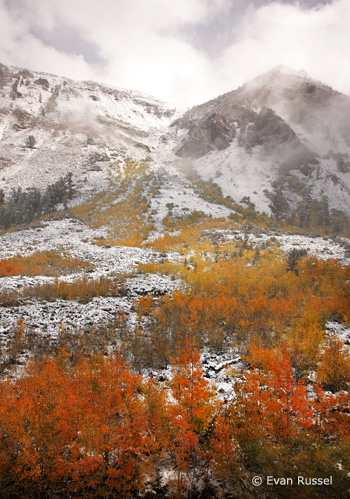
Aspens and snow in the Bishop Creek area, October 5th—Photograph by Evan Russel
While we may have to wait a bit for more color in the valley, this could also mean that all the deciduous trees will change at the same time. Usually the dogwoods and big-leaf maples turn earlier than the oaks and cottonwoods, and the color is spread out over several weeks. But occasionally all the trees turn together, creating some exceptional conditions.
On the eastern side of the mountains the color is not yet at its peak in the middle and lower elevations, but things are starting to change quickly, and color can be found in many of the medium-to-high-elevation aspen groves. I described some of the progress in my last two posts, but will add that on Tuesday I found some nice orange trees in the upper reaches of Lee Vining Canyon, along Highway 120. These aspens had shown very little color only three days earlier. The next two weeks could be great in places like Lundy Canyon, Lee Vining Canyon, June Lake Loop, and Conway Summit.


